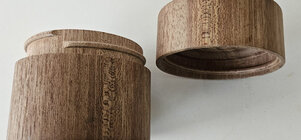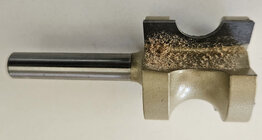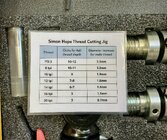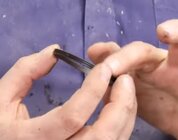Purchased every one. Sold every one. But the baxter.I've seen or tried them all but for me there is nothing even close to being better than the Baxter Threading Jig. Expensive, yes but you are getting a quality beautifully machined super accurate instrument. I have two, do you need two? Probably not but they are so good that when the opportunity came up to get the second one I just got it. And yes I do use both as they are different sized and fit different lathes.
-
December 2025 Turning Challenge: Single Tree! (click here for details) -
Congratulations to Bob Henrickson, People's Choice in the November 2025 Turning Challenge (click here for details) -
Congratulations to Steven Gordon for "Dropped Ice Cream Cone" being selected as Turning of the Week for December 8, 2025 (click here for details) -
Welcome new registering member. Your username must be your real First and Last name (for example: John Doe). "Screen names" and "handles" are not allowed and your registration will be deleted if you don't use your real name. Also, do not use all caps nor all lower case.
You are using an out of date browser. It may not display this or other websites correctly.
You should upgrade or use an alternative browser.
You should upgrade or use an alternative browser.
Hope Threading Jig
- Thread starter Bill Alston
- Start date
Buy the Hope jig. You won't be disappointed.I’m seriously considering buying the Hope Jig. The alternative is to buy a cutting head and cutter and make the rest. The cutting head is, I think, a really good deal at only £69. It’s certainly quite affordable to have at least two or even three of different pitches. The flip up idea on the Hope looks extremely useful so if I do make one it would have to include this feature. I’m quite surprised that other makes haven’t included this idea. One of my club members bought the Hope jig a little while ago so I’ll have to visit him to have a good examination of it. I’m part way through another project at the moment so I’ll revisit this when it’s nearer completion.
Reed, I’ve seen a couple of different ways of making the setup of the Hope/Chefware jig much easier, so I honestly don’t think this will present any problems for me. I see placing a simple set square across the bed together with an index of some sort between the jig and banjo as a probable solution when the time comes.
I use the 16tpi for small boxes and the 12tpi for cremation urns.
You can buy his stuff from Black Forest Woods in Calgary.My understanding is that Simon Hope does not sell to the US. For boxes 2" and smaller I prefer to hand chase threads at 16TPI. Larger boxes and urns I generally will cut 10TPI with a Chefware Kits jig as I am typically using woods that will not hand chase well.
Here's a link to their page: Black Forest Wood CompanyBuy the Hope jig. You won't be disappointed.
I use the 16tpi for small boxes and the 12tpi for cremation urns.
You can buy his stuff from Black Forest Woods in Calgary.
I have the Chefware Kits Jig and have thought about this quite a bit. I don't believe you are in fact cutting a tapered thread like a pipe thread. Because you are moving the workpiece past a fixed cutter point, I think all you are doing is slightly changing the shape of the thread, from /\/\/\/\ to something like |/|/|/|/ (only not that exaggerated).Sounds like what you did was cut a thread like a tapered pipe thread. Might even be a good idea to have a bit of taper in threads to account for seasonal distortion.
Frankly, I eyeball the alignment between the chuck body and the lathe ways and have no issues with the shape of the thread as long as the two pieces screw together. It's wood, after all, and isn't going to be landing on Mars.
Does anyone have 'hands-on' experience with the latest version of the Chefware Jig? GrJensen (above) mentions that it now has a click-stop function. It would be a fabulous help to see an overview of the more recent iteration of the kit as the videos on YouTube are of jigs that are many years old.
Any other advantages between the two? Perhaps we could generate a table comparing the two? I am happy to compile and post here if we have comments from those more knowledgeable that I can summarize.
The Chefware kit does have the appeal of being useful for creating spheres, for a modest additional price. Any helpful insight would be much appreciated.
Any other advantages between the two? Perhaps we could generate a table comparing the two? I am happy to compile and post here if we have comments from those more knowledgeable that I can summarize.
The Chefware kit does have the appeal of being useful for creating spheres, for a modest additional price. Any helpful insight would be much appreciated.
I ended up buying the Simon Hope Jig. I got it with the 16tpi then bought a 10tpi spindle for it. I’ve not used it too much so far but I’ve found it easy to use. The documentation, together with the click-stop adjuster makes matching male and female threads very easy.
Sorry. I missed this. I just follow the Hope supplied instructions. I recall reading about climb cut but can’t remember what was different!Are you using a climb cut? Some woods don't do well with a conventional cut
I don't use common 60 degree vee threads. Those may be fine for threads in metal, not so good for wood threads for a number of reasons.
Shown is the bottle type thread I use. Nobody seems to have come up with a cutter to do this on threading jigs. As shown the box is 3" diameter with 4 threads per inch pitch. Single turn to open/close with a bit less than 360 degrees rotation. The thread profile is a circular arc. Look in your refrigerator for a condiment container to see how these threads differ from the usual vee threads. For one thing they allow a much greater clearance between male and female to account for wood movement.
The second picture shows the type cutter used, but that one is way too large for the threads shown. I haven't found any off-the-shelf cutters so I ground the circular shape into a straight flute router bit using an abrasive slitting saws dressed to the circular profile.
These can also be done on a CNC router with no jig needed.


Shown is the bottle type thread I use. Nobody seems to have come up with a cutter to do this on threading jigs. As shown the box is 3" diameter with 4 threads per inch pitch. Single turn to open/close with a bit less than 360 degrees rotation. The thread profile is a circular arc. Look in your refrigerator for a condiment container to see how these threads differ from the usual vee threads. For one thing they allow a much greater clearance between male and female to account for wood movement.
The second picture shows the type cutter used, but that one is way too large for the threads shown. I haven't found any off-the-shelf cutters so I ground the circular shape into a straight flute router bit using an abrasive slitting saws dressed to the circular profile.
These can also be done on a CNC router with no jig needed.


I sent an email with a number of questions to Craig (Chefware Kits) and had a prompt, detailed and polite response. (Italics are Craig's responses)
1. I asked about the 'stop-click' feature that some in this thread mentioned this kit had. The answer is it USED TO but the system has been improved since and a new method introduced
"the clicker knob was a neat feature on our older jig but we found that people didn’t use it and instead (were) just put a few marks on that 2” knob to know when to stop. We replaced it with a 4” aluminum wheel that has a spinning disk that can lock. So the process is you touch the wood with the cutter; zero the wheel and lock it in place the cut the thread it is very easy and simple to do and no counting clicks"
2. I have multiple lathes and didn't want to be tied to one machine (a downside of the Baxter jig)
"You can move our jig between any lathe by simply swapping the jig’s banjo post. depending on the swing we offer a 4”,6”or an 8” post which covers ever lathe on the market. a new post cost $29 and includes a height ring so the jig is on center when you goto use it"
3. I also asked him about the Hope swing- away hinge. He had some good points to make about their banjo based design.
"Checking a thread by its nature with a jig that has a banjo post allows it to swing out of the way to check the fit using the threaded wood lid. You then swing the cutter back into position very easily and accurately to cut more threads if needed. Once a turner gets a few boxes threaded it’s a simple task that is part of the process. ....mike peace on youtube actually just spoke about this in his last video"
I do find the Chefware kit intriguing and it is USA made....
1. I asked about the 'stop-click' feature that some in this thread mentioned this kit had. The answer is it USED TO but the system has been improved since and a new method introduced
"the clicker knob was a neat feature on our older jig but we found that people didn’t use it and instead (were) just put a few marks on that 2” knob to know when to stop. We replaced it with a 4” aluminum wheel that has a spinning disk that can lock. So the process is you touch the wood with the cutter; zero the wheel and lock it in place the cut the thread it is very easy and simple to do and no counting clicks"
2. I have multiple lathes and didn't want to be tied to one machine (a downside of the Baxter jig)
"You can move our jig between any lathe by simply swapping the jig’s banjo post. depending on the swing we offer a 4”,6”or an 8” post which covers ever lathe on the market. a new post cost $29 and includes a height ring so the jig is on center when you goto use it"
3. I also asked him about the Hope swing- away hinge. He had some good points to make about their banjo based design.
"Checking a thread by its nature with a jig that has a banjo post allows it to swing out of the way to check the fit using the threaded wood lid. You then swing the cutter back into position very easily and accurately to cut more threads if needed. Once a turner gets a few boxes threaded it’s a simple task that is part of the process. ....mike peace on youtube actually just spoke about this in his last video"
I do find the Chefware kit intriguing and it is USA made....
The Hope Jig seems to have gone through continuous development. I believe the first model didn’t have the swing away feature. A swing away plate was then added to the next version. The current model has the swing away feature built into the basic design now and doesn’t require the plate used in the previous version.
I personally have found the click feature pretty foolproof when used with the included instructions. I did though produce my own laminated card as a handy reference.

I personally have found the click feature pretty foolproof when used with the included instructions. I did though produce my own laminated card as a handy reference.


